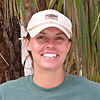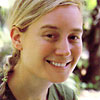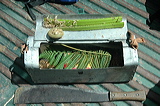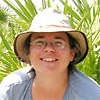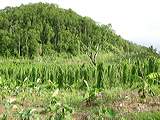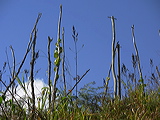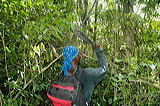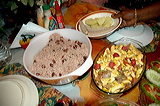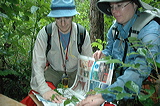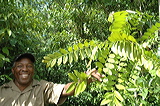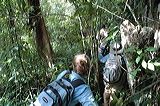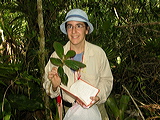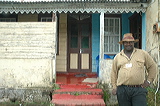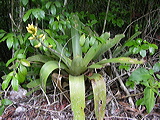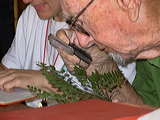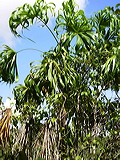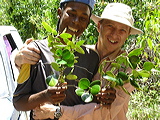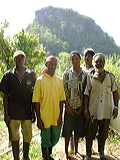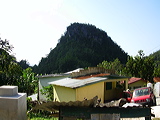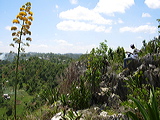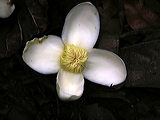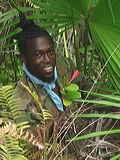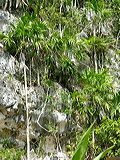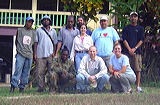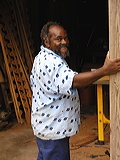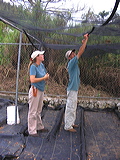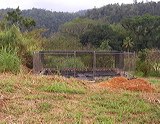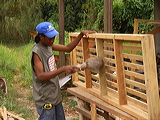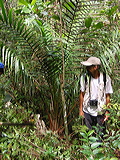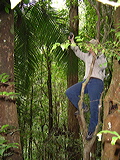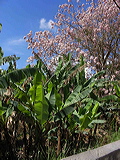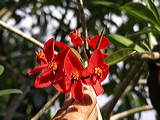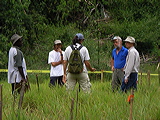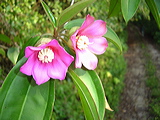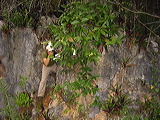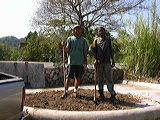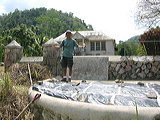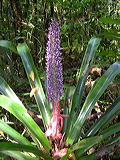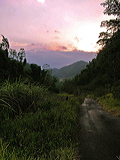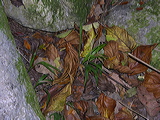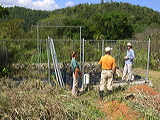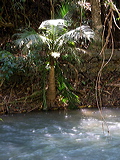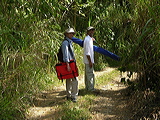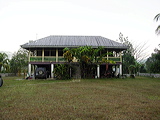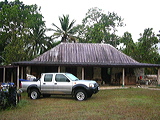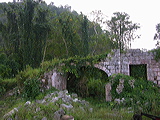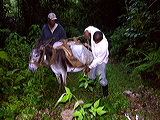 |
| Ian and Delroy securing our water and gear on Gladys (KW) |
We got up at the crack of dawn, downed some coffee, and piled in the car: Ruffy, Jennifer, Jason, Kristie, and myself. We stopped along the way to pick up Ian and Delroy, and bumped our way along the road until the truck could go no further on the rocky incline.
Fortunately we got a tip from Sugarbelly that there was a shortcut we could take on a road that looked off limits, but was actually public and open to everyone. It would shave over two miles off our hike. Just before we reached the end of this road, we picked up Gladys, our donkey. She was calmly waiting for us, her big ears raised, as if in salute. We were all immediately smitten with her.
Ian and Delroy jumped out of the truck and began to lead her up what they called "long mile hill," the first part of our journey. We were able to start the ascent in the truck, but we didn't get very far. As fate would have it, we started our hike at the very point we had reached on foot on a previous visit to Jamaica. Getting there last time required an arduous hike of more than an hour. We thanked Sugarbelly again for saving us that first leg of the trip.
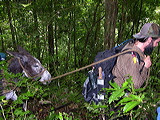 |
| Jason leading Gladys over difficult terrain (KW) |
After loading up Gladys and shouldering our own large packs, we slowly made our way up the hill. The trail climbed through a long stretch of old growth forest and it was great to see so many large, old trees. Eventually we started to descend until we reached the bottomlands; the vast majority of the trail winds through the cockpit bottoms where it is much easier to make a path.
Our plan was to select a hill off the trail and to set up transects to compare forest composition on different aspects and elevations of the hill. We were aiming to get deep into the heart of Cockpit Country to see how the vegetation compared to better known sites along the periphery. George Proctor, the country's most authoritative botanist, told us that there were few botanical records from this region, and none from along the trail we were taking, so we were eager to see what we'd find.
As the sun climbed higher, we eventually reached the point where Rumpy and Ian had stopped clearing and a little further ahead we came to our first serious obstacle. An enormous sweetwood tree (Nectandra, in the same family as bay leaves and cinnamon) had fallen across the path. Gladys on her short, spindly legs would not be able to make it across, and there was no way she could walk around. Discouraged, we chided ourselves for not packing a chainsaw, and as we considered our options, Ian decided he would try to hack through the log using only his machete. We stared in disbelief as he pounded away at the cut, as if he had a robotic arm. Gladys stood by calmly, indifferent to the tremendous show of effort made for her benefit.
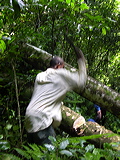 |
| Ian using a machete to clear a fallen log from the path (KW) |
In about twenty minutes Ian had hacked the enormous log in two, and he, Rumpy, Jason, and Delroy shoved the it out of the way so we could lead Gladys through. Soon we encountered other, smaller logs, and Jason hacked through the next one.
The going was getting pretty rough, and finally we reached a small clearing by a giant clump of bamboo that must have been planted at least fifty years ago. The bamboo reminded us that there is no such thing as an undisturbed forest in Jamaica- people have been everywhere on the island!
At the southern end of the clearing were several logs across the trail, and there was no way we could have hacked through them. For Gladys, and for us, this was the end of the trail. We decided to set up our camp there, taking advantage of the relatively even ground and the availability of a makeshift wicker and bamboo table that had been made by other campers before us. This had apparently been a site where wicker was harvested for commercial use in furniture and baskets.
As we unloaded our gear, the clouds started to gather, so we quickly set up our tents and a couple of large tarps to create a roof under which we could cook and sleep. The rain came just as we finished setting up- a strong “man” rain, which in Sugarbelly's terminology refers to a hard, driving rain of short duration, as opposed to “woman” rain, a light rain that goes on throughout the day. We had lunch and waited out the rain, and then we set off to start working on the transects.
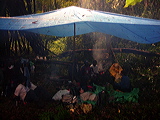 |
| Our campsite in the heart of Cockpit Country (KW) |
We selected a hill about a kilometer south of our campsite, one that was less obviously impacted by human disturbance. We began the slow, steady work of measuring out our plots, 50 x 2 meters, on the difficult, rocky terrain. We sent Rumpy ahead to mark the plots with plastic tape, and next went Jason and Jennifer to gather data about soil/leaf litter depth and to make estimates of the percentage of rock cover in each transect. Kristie and I measured the diameter of every woody plant over 2cm in diameter and estimated tree heights. With the help of Ian, who proved to be an adept tree climber, we collected a voucher specimen of each species as a lasting record of the plants we measured.
I took notes about epiphytes and other herbaceous plants, and Jennifer and Jason worked the hill to do general collecting of any interesting plants in flower or fruit. We worked through the rest of the afternoon until the rains came back and then we headed back to camp.
Hoggy, another local field assistant that we had worked with last time we were in Jamaica, was waiting for us at the camp. He is also a great tree climber and very adept with a pole pruner, so we had asked him to meet us. We were all glad to see him.
We lit some low, smoky fires to keep the mosquitoes away and prepared a frugal dinner consisting of beans and quick-cooking couscous. The Jamaicans had never tried couscous, and it became a joke for the rest of the trip. Gladys was nearby, munching contentedly on the saplings and herbaceous plants of the cockpit bottom. We set up some hammocks under the tarp and turned in shortly after dark.

 August 25, 2006: We leave Cockpit Country with a wealth of new information on its flora
August 25, 2006: We leave Cockpit Country with a wealth of new information on its flora
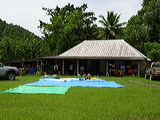




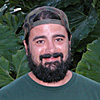
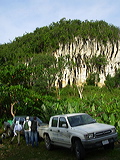
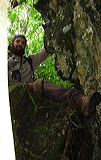

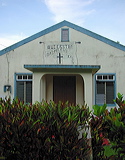
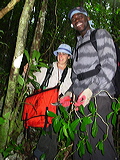


 August 17, 2006: It's the rainy season in Cockpit Country
August 17, 2006: It's the rainy season in Cockpit Country